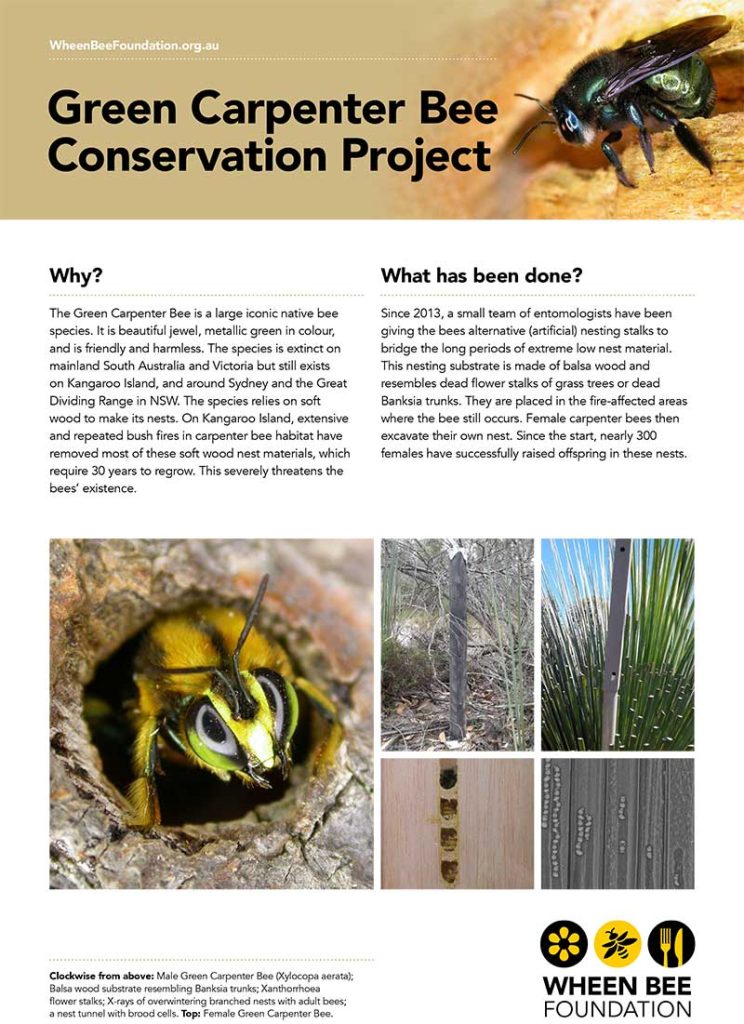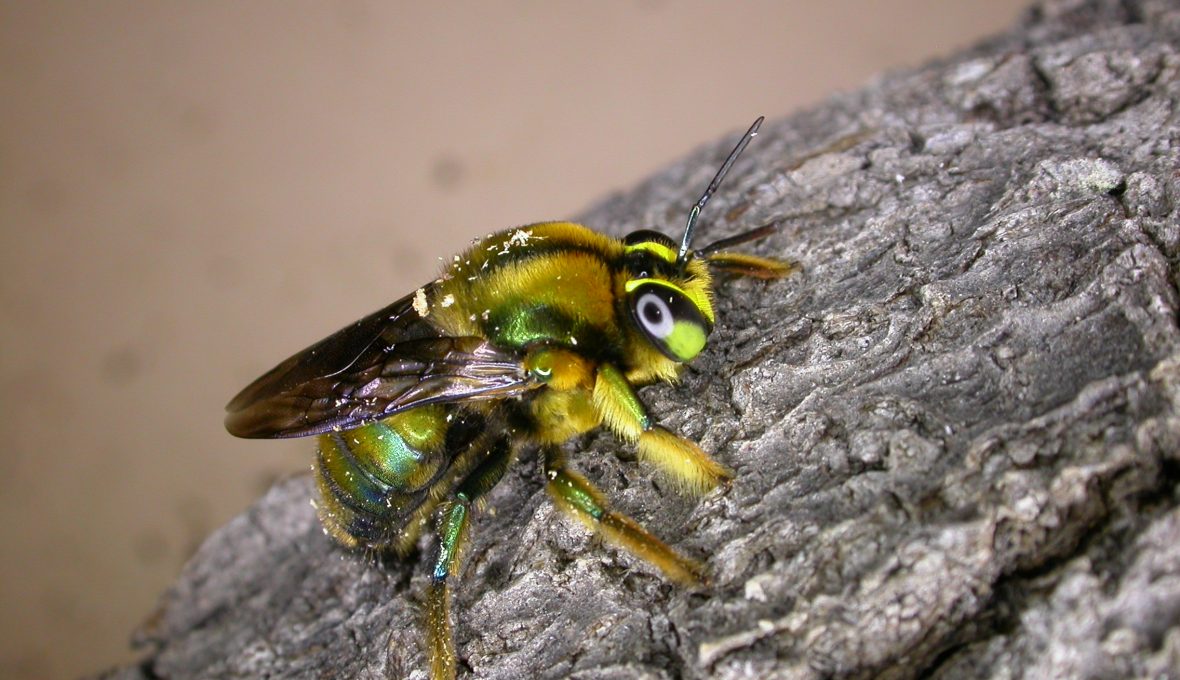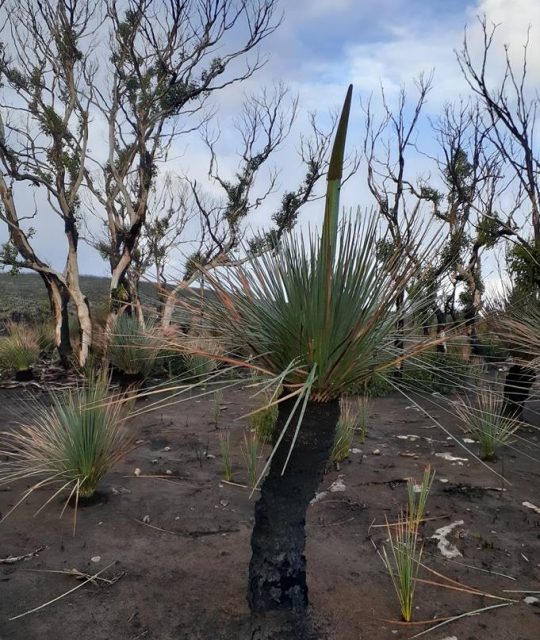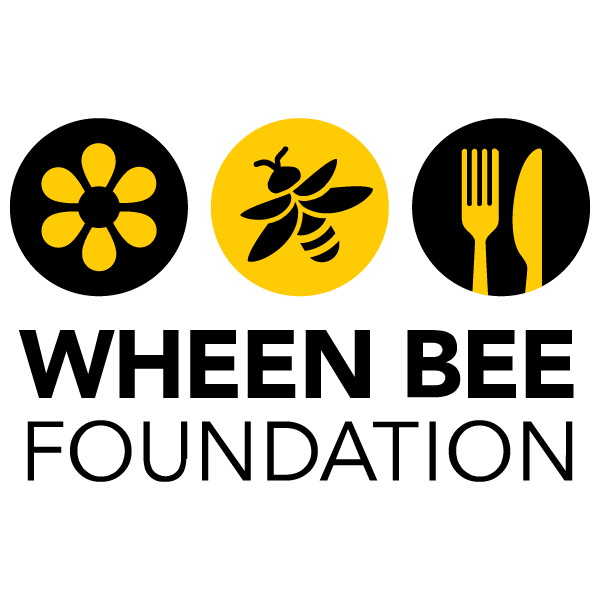Green Carpenter Bee
What is the Green Carpenter Bee Conservation Project?
Wheen Bee Foundation is a proud supporter of the Green Carpenter Bee Conservation Project. Initially started on Kangaroo Island, the focus of this project has recently expanded due to the impacts of the catastrophic 2020 bushfires.
Background
The Green Carpenter Bee is a large iconic native bee species. It is beautiful jewel, metallic green in colour, and is friendly and harmless. The species is extinct on mainland South Australia and Victoria but still exists on Kangaroo Island, and around Sydney and the Great Dividing Range in NSW.
The species relies on soft wood to make its nests. On Kangaroo Island, extensive and repeated bushfires in carpenter bee habitat have removed most of these soft wood nest materials, which require 30 years to regrow. This severely threatens the bees’ existence.
Early research
Since 2013, a small team of entomologists have been giving the bees alternative (artificial) nesting stalks to bridge the long periods of extreme low nest material. This nesting substrate is made of balsa wood and resembles dead flower stalks of grass trees or dead Banksia trunks.
They are placed in the fire-affected areas where the bee still occurs. Female carpenter bees then excavate their own nest. Since the start, nearly 300 females have successfully raised offspring in these nests.
If you have seen a Green Carpenter Bee or a nest entrance in a dry grass tree stalk on Kangaroo Island, researchers would like to hear from you.

Download the Green Carpenter Bee Conservation Project information fact sheet for more information.

Male Green Carpenter Bee (Xylocopa aerata).

Impact of the January 2020 bushfires
At the time of the 2020 fires, there were more than 150 nests in the stalks provided on Kangaroo Island, which contained mature brood. These all burnt. In NSW, the species has also been severely impacted, with much of its natural range burnt.
Further research
To fully appreciate the impact, surveys will need to be undertaken.
On Kangaroo Island, a few remnant natural nests may still exist in unburnt areas.
If that is the case, raised funds and local community support will be used to try to nurse the population back to health and into the conservation areas.
If there are insufficient bees left, there may be an opportunity for a reintroduction from NSW, but the conservation status there needs to be assessed before we undertake such action.
Research requires support
- On Kangaroo Island, we will need to double our previous effort, and set out 600 nests per year, which will cost $10,000 per annum.
- A survey for the presence of bees in NSW will cost $5,000, and will involve training of, and help by volunteers.
- A large-scale reintroduction project in areas where the bee has been affected or has gone extinct in the past could reduce the risk of extinction due to future bushfires.
- Such a large-scale project requires the appointment of a coordinator under our supervision.
We will only embark on this after we have undertaken a Species Recovery Plan.
- This Species Recovery Plan will assess current and future natural nesting opportunities in protected areas in NSW and Victoria (the Grampians), fire management strategies and modelled fire frequency.
- This will take 6 months and cost AUS$50,000 (salary and travel).
- It can start as soon as the fires are finally out and the survey has been finalised.
- Funds are currently available to support the immediate nesting substrate material replacement costs for 2 years.
We urgently need funds to cover the survey and Species Recovery Plan that are necessary to redesign the way forward to ensure the survival of this beautiful bee species in the current post 2020 bushfire context.




